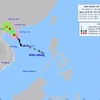Hanoi (VNA) – Responding to information about an early winter with record low temperatures for the northern region this year, Nguyen Duc Hoa, deputy head of the climate forecasting division at the National Centre for Hydro-Meteorological Forecasting, said under the impact of La Nina, regions across Vietnam will witness relatively complex weather developments.
Cold waves may come early, and the average temperature in winter this year is likely to be lower than that last year. However, it is hard to say whether or not there will be record cold temperatures since it is still too early to foresee such statistics.
Complex weather changes
- The National Centre for Hydro-Meteorological Forecasting recently predicted that the water surface in the centre of the Pacific Ocean may switch to the La Nina status in later months of 2020. How is this phenomenon happening?
Mr. Nguyen Duc Hoa: At present, ENSO (El Nino-Southern Oscillation) is gradually changing to the La Nina status.
Sea surface temperatures in the central area of the Pacific, also called the Nino 3.4 region, have decreased compared to early September and will continue to cool down. The sea surface is likely to switch to the La Nina status in later months of 2020 and early 2021, but may be weak and last for a short period of time.
- Studies found that when the atmospheric status changes to La Nina – the cool phase of the El Nino-Southern Oscillation, the Western Pacific Region, including Vietnam, will record more rains, storms and floods. How will these develop from now to the end of the year?
Mr. Nguyen Duc Hoa: Due to the impact of La Nina, weather in regions of Vietnam will develop in a relatively complex way.
Here are some typical features of the La Nina impact’s on local weather: Usually, in years with La Nina conditions, cold waves tend to arrive early, resulting in an average temperature approximating or lower than the average. There are more storms and tropical depressions appearing in the East Sea and affecting the mainland, and the storm season often lasts until year-end months.
Rains also tend to increase compared to the average in the central and southern regions. Notably, due to the impact of La Nina, the Central Highlands and southern regions also witness more off-season rains.
It is forecast that from October to the end of 2020, there will be 5 – 7 storms and tropical depressions in the East Sea, including 3 – 4 directly affecting the country’s mainland, mostly in the central and southern regions.
In beginning months of 2021, tropical depressions may still appear in the southern East Sea and affect the south-central and southern regions. Prolonged heavy rains are likely in the central region, especially central and southern areas of this region, in October and November 2020.
In the 2020 – 2021 dry season, it is highly likely that off-season rains will occur in the Central Highlands and southern regions.
Unable to make too early predictions
- You said this year, cold waves tend to come early with temperatures lower than last year. Could you elaborate on this?
Mr. Nguyen Duc Hoa: Average temperatures are not even among regions across the country. In October and January – March 2021, they will approximate the average in the same periods of previous years. In November and December 2020, temperatures nationwide will be 0.5 – 1 degree Celsius lower than the average.
Cold waves are likely to come early, and the average temperature in the 2020 – 2021 winter will tend to be lower than in the 2019 – 2020 winter.
- With such forecasts, are record weather statistics likely?
Mr. Nguyen Duc Hoa: It is unable to foresee dangerous weather conditions and record statistics too early because long-term forecasts may have very big errors. The accuracy rate is about 65 – 70 percent in forecasts for months and 60 – 65 percent in those for seasons or six months.
More detailed predictions can be made 10 days early. Therefore, abnormal weather conditions like intense cold or lowest temperatures can only be foreseen 10 days ahead, and snow warnings, 1 – 3 days.
So, to have more accurate information, it is necessary to stay updated with weather forecasts for each day and 5 – 10 days published on the forecasting centre’s website at www.nchmf.gov.vn./.
- Thank you very much!


























